PADI Open Water Diver Manual Answers Chapter 4 explained to get ready for the exam and understand the PADI Open Water Knowledge Review 4 Answers.
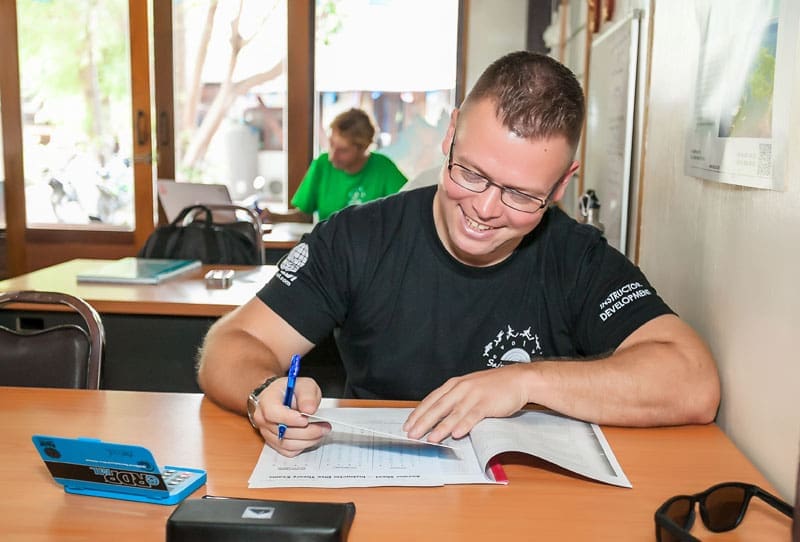
In PADI Open Water Diver Manual Answers Chapter 4 we focus on more medical questions. In chapter 4 we cover alcohol, smoking, medication, nitrogen, and decompression theory.
Question 1 – PADI Open Water Diver Manual Answers Chapter 4
Question 1: How to use a clean-up mesh bag underwater?
Never attach a full mesh bag to your scuba equipment as you can get entangled and hard to drop in an emergency. Always hold it in your hands so you can easily drop it if needed.
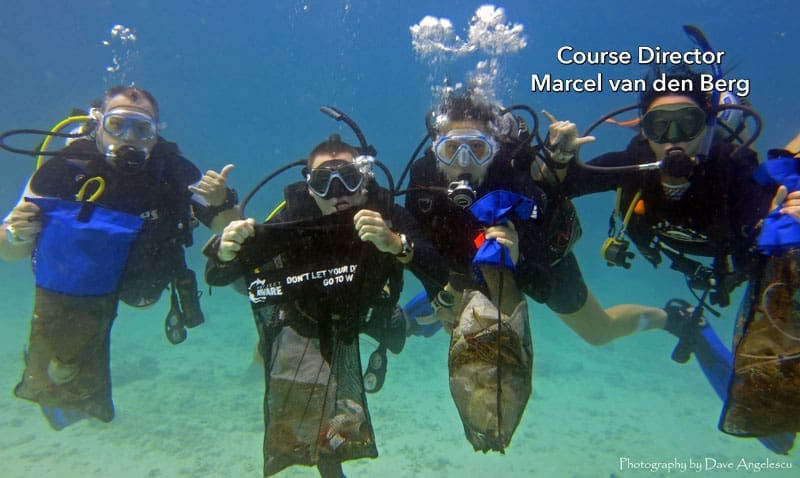
Question 2 – PADI Open Water Diver Manual Answers Chapter 4
Question 2: Should you scuba dive with a cold or congestion?
You should never dive with a cold as that causes congestion which can block your sinuses, lungs, and other airways. This makes equalizing hard and you can risk a squeeze, reverse block, or lung overexpansion.

Take some rest, drink lots of water and continue diving when you are healthy again. Always check with a physician before your next dive if you are fit enough.
Question 3 – PADI Open Water Knowledge Review 4 Answers
Question 3: Cardiovascular conditions and scuba diving.
If you suspect any cardiovascular conditions, are of age or are not in shape you should always do a medical examination with PADI medical statement with a physician to check if you are fit enough to go scuba diving.
Even if the physician tells you that you can dive, you should still avoid swimming hard, carrying equipment, climbing a ladder, long walks wearing gear, and heat stress from wearing an exposure suit in a hot climate.
Question 4 – PADI Open Water Diver Manual Answers Chapter 4
Question 4: Can you drink or use tobacco when scuba diving?
Drinking alcohol before the dive can dehydrate you, reduce your reaction speed, accelerates body heat loss and rational thinking.

Smoking decreases the efficiency of your circulatory and respiratory systems and causes overall health problems.
Question 5 – PADI Open Water Diver Manual Answers Chapter 4
Question 5: Can you use prescription drugs while scuba diving?
Medication can wear out underwater, cause side effects, and might affect your judgment. Always consult your physician to check if you can take your medication while scuba diving.
Question 6 – PADI Open Water Knowledge Review 4 Answers
Question 6: Can you go scuba diving while pregnant?
Very little is known about the effects of diving on a fetus and for this reason, women should not dive while pregnant or trying to become pregnant.
Question 7 – PADI Open Water Diver Manual Answers Chapter 4
Question 7: When should you do a scuba refresher course?
A scuba diving certification never expires, but after some time of inactivity we might lose out on knowledge and diving skills.
You should do a scuba refresher course after 6 months of no diving. You can always take it earlier if you need it or a dive shop might ask you to take a scuba diving refresher before a course or fun dive. A scuba review is called the PADI Reactivate course.
Question 8 – PADI Open Water Diver Manual Answers Chapter 4
Question 8: Can I dive on enriched air (Nitrox) without taking the proper course?
Oxygen problems are unlikely within recreational depth limits using air, but enriched air has higher oxygen content. PADI Enriched Air Diver course teaches you to avoid oxygen problems.
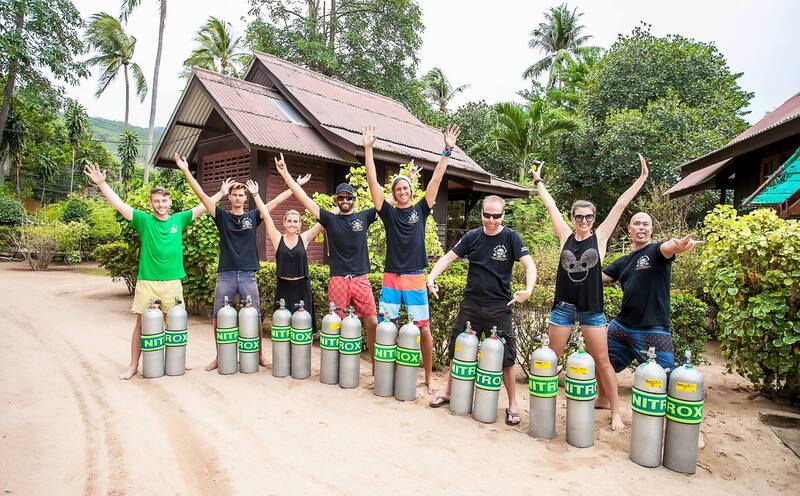
Oxygen toxicity can cause twitching and muscle spasms, especially in the face. This can cause you to drop/spit your regulator from your mouth and this can cause drowning. It is therefore important to never dive with a cylinder labeled “Nitrox,” “EANx” or “Enriched Air Nitrox” unless trained.
Question 9 – PADI Open Water Knowledge Review 4 Answers
Question 9: What are the symptoms of breathing contaminated air?
You can get contaminated air into your scuba cylinder by improper filling procedures. This can lead to carbon monoxide poisoning and causes mild symptoms like a headache, feel ill, dizziness, or worse.
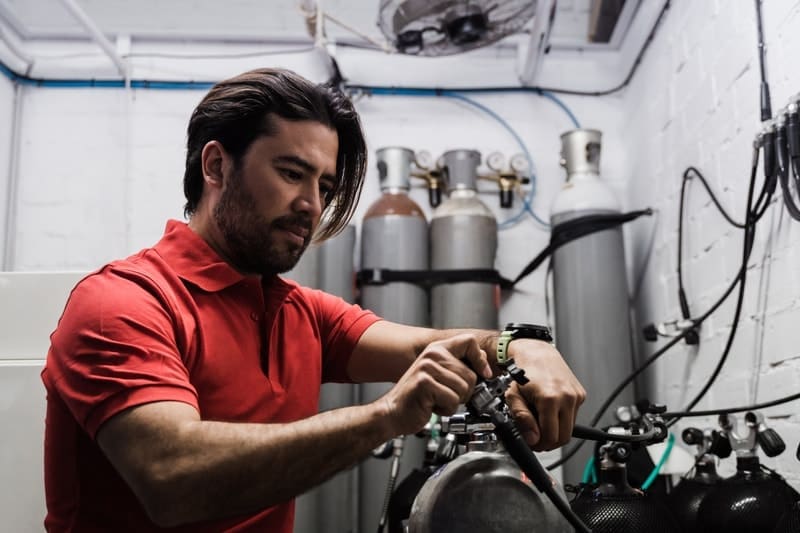
Question 10 – PADI Open Water Diver Manual Answers Chapter 4
Question 10: How to avoid getting contaminated air in your scuba cylinder?
You can visit the filling station and ask for their licenses and diplomas. When in doubt look for another filling station.
Question 11 – PADI Open Water Diver Manual Answers Chapter 4
Question 11: How much nitrogen gets absorbed into our body during a dive?
Under pressure, we dissolve nitrogen into our tissues. The deeper and longer we stay the more nitrogen will be dissolved into our tissues. That is why you should always dive with a dive watch or even better a diving computer as it tracks your nitrogen exposure, depth, and time.
Question 12 – PADI Open Water Knowledge Review 4 Answers
Question 12: What can happen if I go too deep or stay too long while scuba diving?
Decompression sickness is caused by bubbles of nitrogen forming in the tissues and bloodstream that block the flow of oxygen to the tissues.
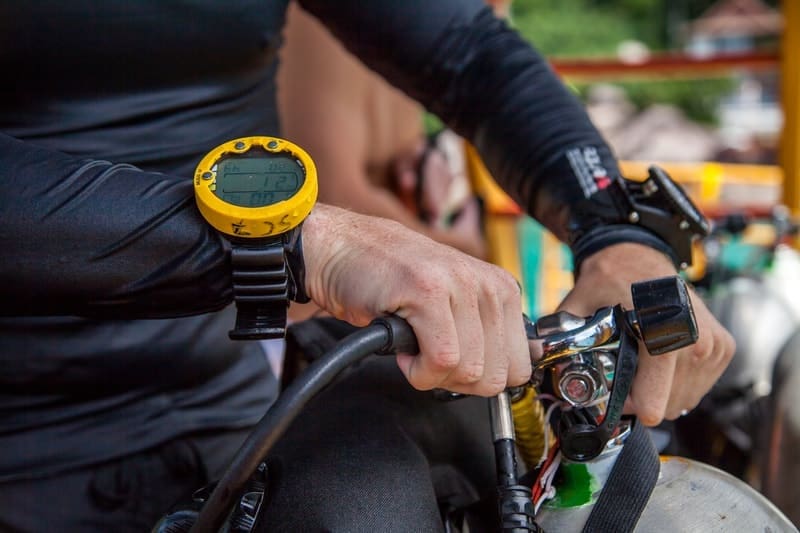
Therefore we want to stay well within our depth and time limits when scuba diving. You can plan this by using the PADI Recreational Dive Planner (RDP) or a diving computer.
Question 13 – PADI Open Water Diver Manual Answers Chapter 4
Question 13: What are the signs and symptoms of decompression sickness?
There are two types of decompression sickness/ DCS:
- Type I: ‘Pain only’, symptoms are not immediately life-threatening.
- Type II: Symptoms that may be immediately life-threatening involving the central nervous system.

In this case, we are talking about Type I: Pain, numbness, tingling, and weakness. These symptoms can get worse and become life-threatening over time.
It is very important to contact a dive physician and do a medical examination anytime you suspect DCS, even with mild symptoms.
Question 14 – PADI Open Water Diver Manual Answers Chapter 4
Question 14: Some factors increase the risk of decompression sickness.
Being dehydrated, stressed, obese, your age, and some injuries can increase the chances of getting DCS while scuba diving.
Question 15 – PADI Open Water Knowledge Review 4 Answers
Question 15: What do we mean by a No-Stop dive?
When you stay within the No Decompression Limits (NDL) of the RDP you can always slowly ascend directly to the surface without stopping if necessary (do make a safety stop).I
f you exceed the NDL from your computer or RDP you need to make an emergency decompression stop.
Question 16 – PADI Open Water Diver Manual Answers Chapter 4
Question 16: The deeper we dive the shorter our NDL will be.
The deeper we dive the shorter our no stop limits become. This has to do with the increase of pressure and how much nitrogen we dissolve into our tissues.
Question 17 – PADI Open Water Diver Manual Answers Chapter 4
Question 17: What is the maximum ascent rate?
The maximum ascent rate is 18meters/minute. As people’s physiology differs we always recommend going slower than that. To be honest the slower is always better so take your time. Make sure you plan your dives correctly to have enough air for a slow ascent.
If the ascent is too fast, the difference in pressure of nitrogen dissolved in the body and the surrounding pressure (pressure gradient) is too great. Nitrogen comes out of solution faster than it can be eliminated from the body and forms bubbles and may result in decompression sickness, DCS.
Question 18 – PADI Open Water Knowledge Review 4 Answers
Question 18: How will repetitive dives affect your NDL?
Your body releases some, but not all, of the absorbed nitrogen during a surface interval. On a repetitive dive, dive computers or tables account for this residual nitrogen by shortening no stop limits.
Question 19 – PADI Open Water Diver Manual Answers Chapter 4
Question 19: Can you share a dive computer?
Your dive computer tracks your dive profile, surface intervals, and nitrogen levels. Therefore you need to use the same computer for all the dives that day to get accurate personal calculations and readings. Never share a dive computer with another scuba diver.

Question 20 – PADI Open Water Diver Manual Answers Chapter 4
Question 20: should you always follow the most conservative dive computer?
Depending on the dive conditions and depth you sometimes reach one limit before the other. You should turn the dive when you reach either of the limits, depending on which one comes first.
Question 21 – PADI Open Water Knowledge Review 4 Answers
Question 21: What are the dive computer guidelines?
Always follow the dive computer guidelines:
- Dive computer guidelines:
- Dive the plan – don’t exceed planned limits
- Stay well within computer’s limits
- Follow most conservative computer
- Watch air supply
- Start at the deepest point and go shallower
- Ascend slowly
It is important to carefully read your dive computer manual before using it, as guidelines can differ depending on the brand/model dive computer.
Question 22 – PADI Open Water Diver Manual Answers Chapter 4
Question 22: What should you do when your computer fails during a dive?
Although computer failure is very rare, if it happens, end the dive. Don’t continue without information about depth, time, and nitrogen level. After surfacing, wait 12 or more hours before diving with a different computer.
Question 23 – PADI Open Water Diver Manual Answers Chapter 4
Question 23: It is important to be an environmentally-friendly scuba diver.
Coral reefs are very delicate and easily damaged. Most marine life relies on healthy reefs and it is therefore important to have environmentally-friendly dive skills.
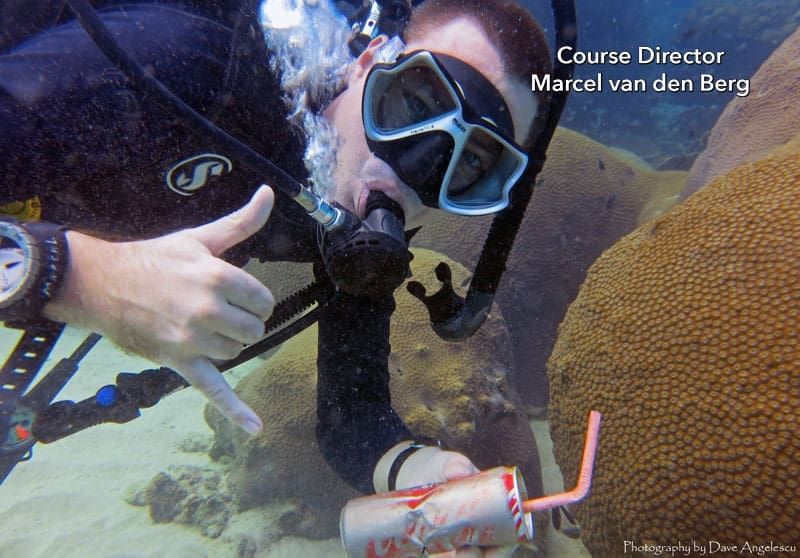
This includes good buoyancy, never touch anything, dive slowly, and don’t litter on the dive site. We also recommend removing any garbage you might find on a dive site to help preserve the natural beauty for other divers and generations to come. Another great way to become an environmentally-friendly diver is to support Project AWARE.
Always review your PADI Open Water Diver Manual Answers Chapter 4 with a certified PADI Diving Instructor and PADI Dive Shop during your PADI Open Water Diver Course. Read full disclaimer here.
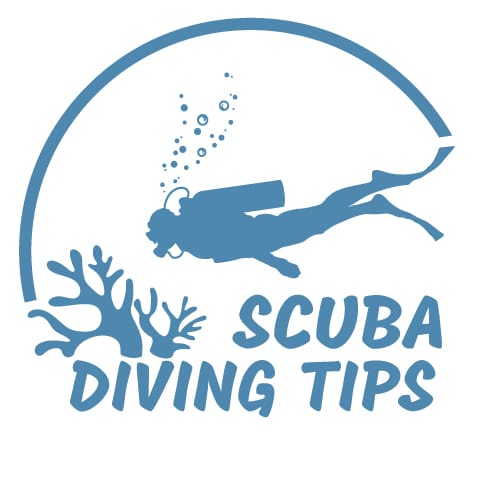

Leave a Reply